Following a recipe is a great way to get started in the kitchen. However, once you’ve gotten the hang of it, you can learn the few choice ratios that govern dozens of different dishes — and free yourself from the restrictions of recipes. Here’s how it works.
Why Ratios Are More Powerful than Recipes
Cooking can be daunting, but what you may not know is that a lot of foods are governed by some very basic maths. Once you understand it, you’ll always be able to make a batch of freshly baked bread, make a rich and savoury sauce, or mix up a simple syrup to sweeten cocktails or drinks. Knowing these ratios is liberating (you’ll never buy a pre-made box or mix again), and they serve as a platform for you to begin experimenting with your own favourite flavours and ideas. Think about it: once you’ve mastered how to make any bread, it’s just a few minor tweaks to make something special, like sourdough or herb bread, or to try something entirely new that you dreamt up, no recipe required.
Professional chefs understand the power of these ratios (although they don’t refer to them as such) — they’re part of any basic culinary education. This is also why professionals don’t need to fumble for a recipe every time they need to make bread, and why a good chef can instantly scale a recipe from a family of four to a banquet of 400 without worry. So can you.
We touched on this topic a while ago when we sat down with Michael Ruhlman to talk about his book, Ratio: The Simple Codes Behind the Craft of Everyday Cooking. Back then, we talked about the kitchen hacks that inspired the book. Now we’re going to get into how to apply those age-old tricks in your kitchen.
What You Should Know Before Start
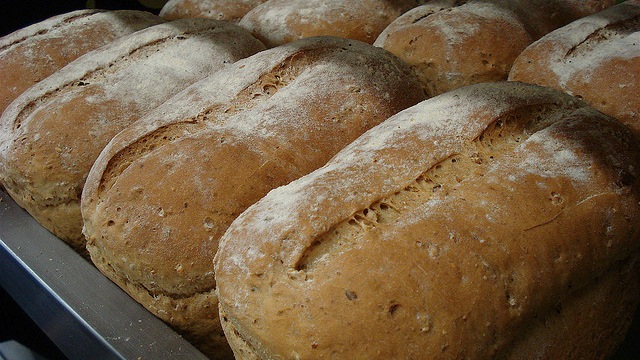
Before we begin, you’ll see a lot of ratios that call for “x parts of one ingredient for every y parts of another ingredient”. When a ratio calls for “parts” they’re talking about the same measurements, in weight, across the board. That means you’ll have to apply a little savvy — instead of thinking “3 cups of flour and one cup of water,” you need to think “10 ounces of flour and 6 ounces of water,” because a “cup” of flour can vary. To address this problem, a good kitchen scale, a tool we think you should have (both for better cooking and healthier eating) is invaluable. It’s a shift in thinking, but scaling a recipe up to feed a crowd or down to feed yourself is ridiculously easy once you get used to weighing your ingredients properly.
The Basic Ratios: Bread, Pie Dough, Pasta and Pancakes
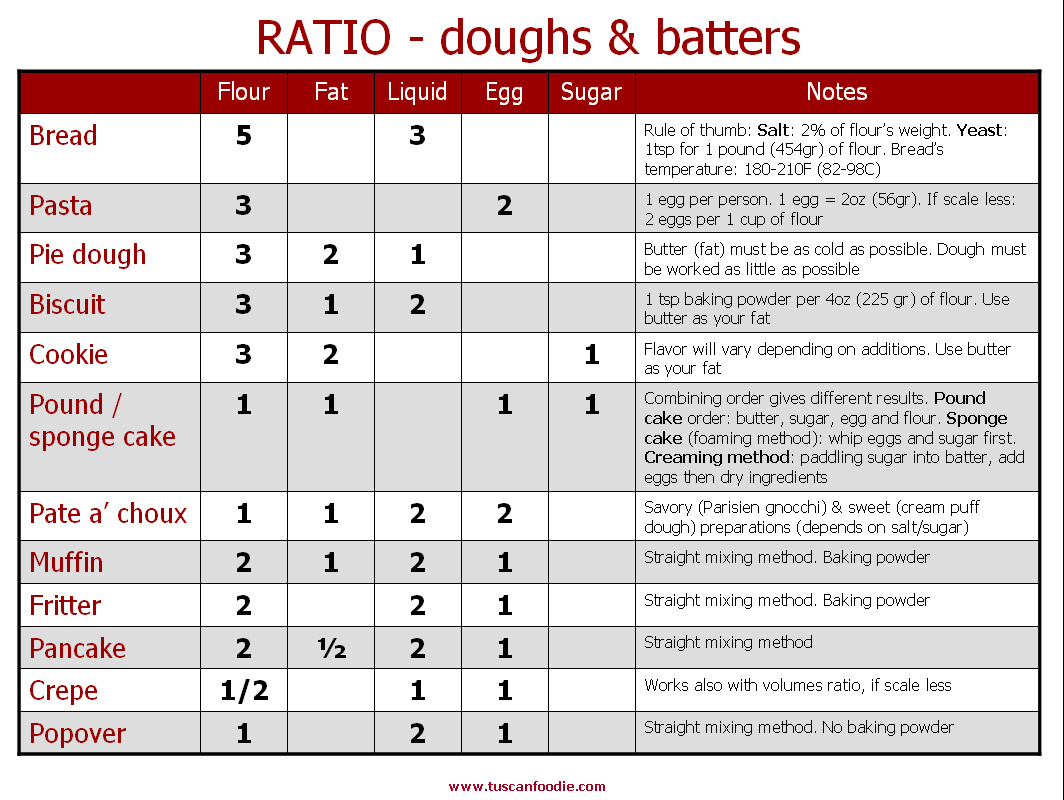
Ironically, even though it’s one of the most basic foods, many of us still struggle with baking bread. Sure, baking is a more precise affair than other forms of cooking, but it’s not as daunting as you may think. These basics will serve you well in almost any case.
The chart above (click to enlarge) is from A Tuscan Foodie in America. Here are a few basic bread and dough ratios that you can put to good use right now:
- Bread is generally 5:3, flour to water (plus yeast/baking powder and salt). Almost any bread dough follows this general ratio. You’ll also need to add salt (a pinch is enough for a small batch, but the general rule is about 2 per cent of the weight of the flour) and yeast or baking powder for leavening (1 teaspoon for baking powder for every 140 grams of flour, or 1 teaspoon of yeast for every 450 grams of flour). From there, the sky’s the limit on the flavour or type of bread you want to make. You’re free to add herbs like rosemary or thyme for an herbed bread, or lemon and poppyseeds (as Ruhlman suggested) for a savoury quickbread.
- Pie Dough is always 3:2:1, flour to fat to water. This one’s universal, barring any of your mum’s secrets for a perfect pie crust, like using vodka (although, really, that one applies too) or working the dough over as little as possible. Just remember to keep your fat cold.
- Pasta is always 3:2, flour to egg. Homemade, fresh pasta is a wonderful thing, but it doesn’t have to be some artisan thing you get as a specialty market. Making your own is as easy as stirring up flour and eggs by hand into a dough and rolling it out. Tuscan Foodie suggests assuming one egg per person when you craft your ratios, and, again, weigh everything. 3:2 tells you how much everything should weigh, not how many eggs to use.
- Cookies are 3:2:1, flour to fat to sugar. Of course, this will vary a bit depending on the other things you plan to add to your cookies, but basic sugar cookies follow this ratio very closely. If you plan to add a mess of chocolate chips, or something else relatively sweet, you may want to scale back on your sugar a little bit. If you plan to add something thick like peanut butter, you may want to pull back a little on the fat. Still, this is a good jumping off point for any cookie recipe.
- Pancakes are usually 2:2:1:0.5, flour to liquid to egg to fat (butter). This one’s a little trickier, but you could just mix everything up in this ratio and come out with delicious pancakes. The key here is that the best pancakes require a little sugar (a few teaspoons), maybe a teaspoon of vanilla extract for flavour, a few teaspoons of baking powder to make them fluffy and so on. You can experiment here, but the key is to understand that simple pancakes are really easy. The liquid you use can be milk or water, it’s up to you, and the fat can be oil or butter (although I’d suggest the latter).
- Crepes are always 1:1:0.5, liquid to egg to flour. If you’re ready to take things to the next level, a good (Western-style) crepe batter is actually really simple to make (and much easier than actually cooking the crepes). It’s just milk, egg and flour. You can add aromatics to the batter if you want, like herbs or a dash of ground spice to make your crepe batter stand out.
Remember, these ratios are the basics, and they always apply, whether you’re making a big batch or small batch. They’re also jumping off points. If you find your pancakes aren’t as fluffy as you prefer, you’ll want a teaspoon or two of baking soda. If you find your cookies are too sweet, you can cut back on the sugar.
You may still want to consult a line-by-line recipe if you’re making something specific, but one thing is certain: Once you have your measurements down and you know your basics inside and out, you’ll look at those recipes for their additives and their alternative ingredients, not for instruction. After all, you’ll already know how to make bread, you’ll just want to know how to make a special kind of bread.
Beyond Baking: Sauces, Dressings and Stocks
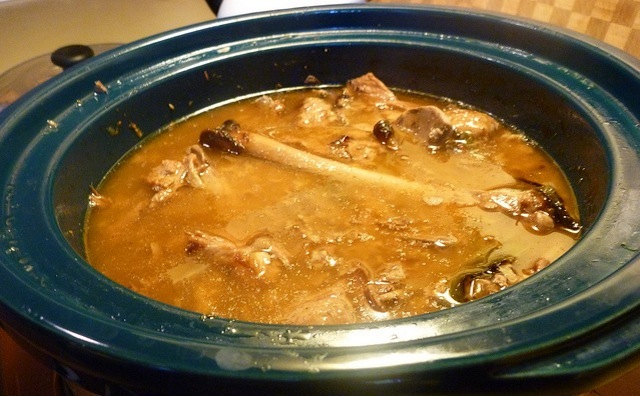
Ratio cooking is ideal for recipes that have common ingredients, which is why it works so well with breads, baking and other pastries, but that’s not the end of it. Many simple sauces, stocks and roux are also governed by simple mathematics, simple “this much this to that much that” descriptions. Here’s what we mean:
- Vinaigrettes are always 3:1, oil to vinegar. Simple and easy — no matter what kind of vinaigrette you plan to make, this simple ratio should help you make it — and the best part is that once you start making your own, you’ll never buy pre-bottled salad dressing again. Mix up some balsamic with a nice olive oil, and you’re done. Expand the idea a bit by adding some diced shallots or chopped herbs for a little added freshness and flavour.
- Mayonnaise is 20:1, oil to liquid (plus yolk). Homemade mayo is a bit of a tricky one, since that “liquid” is usually water and/or lemon juice. Depending on the kind of mayo you want to make, you may use more water than lemon, lime instead of lemon, all lemon and no water, and so on. The egg yolk plays a significant role too — usually about one yolk for a solid cup of mayonnaise. Mix it all up with a standing mixer, immersion blender, whatever it takes to get a good emulsion, or proper suspension of that oil and liquid. Ruhlman notes in his book that most emulsions break due to insufficient water, not insufficient yolk, so don’t worry about the lack of egg. Don’t be afraid to toss in other flavours either — herbs, shallots, salt to taste, even cayenne pepper for heat. Remember, the ratio is the baseline and the only limit is your tastes.
- Brines are usually 20:1, water to salt. This ratio will give you a simple brine, no matter what you want to put into it. If you’re brining a turkey, it will do the job. A few pork chops or a chicken you plan to roast? Sure. It’s a perfect starter recipe — but the beauty of a brine is that it doesn’t just keep meat moist, it can also impart flavour, which is why many brines also add sugar, pepper, herbs and other spices. I’m a big fan of Bon Appetit’s “Simple” Brine, which is a riff on Alton Brown’s classic brine recipe. All of them however, follow this simple rule.
- Stocks are, generally, 3:2, water to bones. Want to make your own chicken or beef stock? Next time you roast a chicken (or even get a rotisserie chicken from the supermarket) or cook a bone-in beef roast, save the bones. Then get a nice big pot (or use your crock pot), and add in three parts water to two parts of the bones from your old meal. That alone will get you a simple stock. As usual, you can doctor it up with salt, herbs and other seasonings, but this basic ratio will hold true and net you a stock that’s good for anything.
These are just the tip of the iceberg. Hollandaise follows a similar rule (5:1:1, butter to yolk to liquid), but it’s a bit more complicated, and we don’t want to do it a disservice by oversimplifying it. Even custards and cremes follow their own ratio rules, and you’ll be able to make as many variations as your heart desires once you learn to see them in the recipes you find. While these ratios came from a number of places, Ruhlman’s book focuses on them significantly, and he even offers up some recipes for specific types of mayo, a perfect consomme and more.
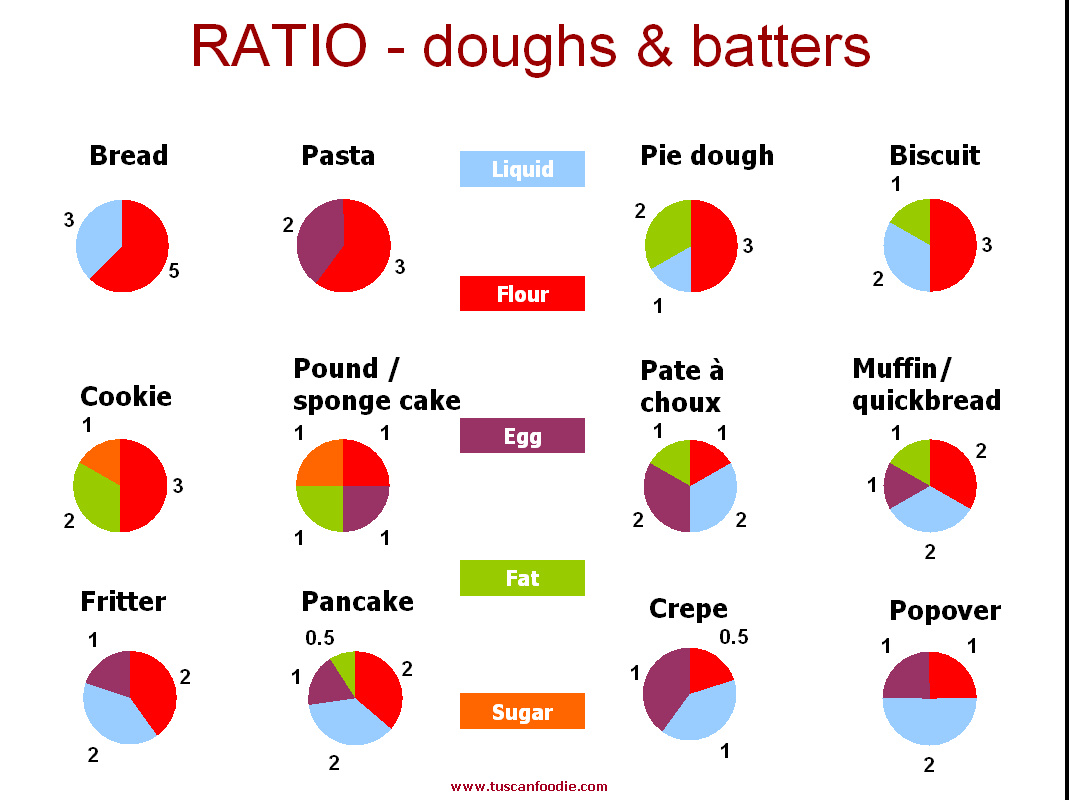
We can’t stress enough that if you’re really interested in this and want to take it to the next level, his book is worth picking up. There’s also an iPhone app and Android app that focus on the ratios and have built-in calculators to translate measurements for you. As we mentioned above, Tuscan Foodie in America has a few more ratio charts (like the version above) that you can print out and keep around the house.
Perhaps most importantly, learning a few simple ratios for the things you like to (or want to) cook empowers you to look past line-by-line recipes and explore your own favourite flavours and ingredients in the dishes you already know and love. Sure, you could just Google someone else’s recipe for a lemon and poppy seed bread, if you want one, but if you know how to make a quickbread just the way you like it because you understand the ratios involved, adding the lemon and poppy seeds is just a matter of buying them and incorporating them into your known, good, household practice. As Ruhlman notes, when you understand how a ratio works, it’s not like knowing one recipe — it’s like knowing all of them.
Photos by v.s.anandhakrishna (Shutterstock), Christopher Elwell (Shutterstock), A Tuscan Foodie in America, net_efekt, and Laurel F.
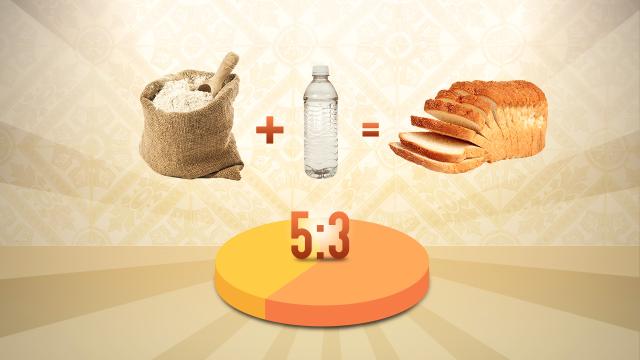
Comments
One response to “How To Free Yourself From Recipes With A Few Golden Cooking Ratios”
I really like this. My ratio for crepes has always been one egg per person, then three tablespoons of flour per egg, then enough milk to make it runny.
No, it blows. Or, more precisely, it would have blown less if metric measurements had been used instead of imprecise, non-sensical imperial measures. Bah!